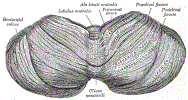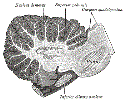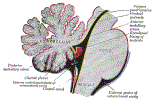Cerebellum Anatomy, Cerebellum
- See Also
- Definitions
- Anatomy
- General
- Communication with Brainstem
- Superior peduncle
- Middle peduncle
- Inferior peduncle
- Vascular
- Anatomy
- Images
-
 Lewis (1918) Gray's Anatomy 20th ed (in public domain at Yahoo or BartleBy)
Lewis (1918) Gray's Anatomy 20th ed (in public domain at Yahoo or BartleBy)
-
 Lewis (1918) Gray's Anatomy 20th ed (in public domain at Yahoo or BartleBy)
Lewis (1918) Gray's Anatomy 20th ed (in public domain at Yahoo or BartleBy)
-
 Lewis (1918) Gray's Anatomy 20th ed (in public domain at Yahoo or BartleBy)
Lewis (1918) Gray's Anatomy 20th ed (in public domain at Yahoo or BartleBy)
-
 Lewis (1918) Gray's Anatomy 20th ed (in public domain at Yahoo or BartleBy)
Lewis (1918) Gray's Anatomy 20th ed (in public domain at Yahoo or BartleBy)
-
 Lewis (1918) Gray's Anatomy 20th ed (in public domain at Yahoo or BartleBy)
Lewis (1918) Gray's Anatomy 20th ed (in public domain at Yahoo or BartleBy)
-
 Lewis (1918) Gray's Anatomy 20th ed (in public domain at Yahoo or BartleBy)
Lewis (1918) Gray's Anatomy 20th ed (in public domain at Yahoo or BartleBy)
-
 Lewis (1918) Gray's Anatomy 20th ed (in public domain at Yahoo or BartleBy)
Lewis (1918) Gray's Anatomy 20th ed (in public domain at Yahoo or BartleBy)
- Exam
- Signs
- Cerebellar Lesion Effects
-
Ataxia
- See Ataxia
- See Acute Cerebellar Ataxia
- See Cerebellar Gait
- Altered Posture and gait
- Patient falls on the same side as a CNS Lesion
- Incoordinated movement
- Dysmetria (overshooting on Finger-Nose-Finger Test)
- Dysdiadochokinesia (difficult Rapid Alternating Movements)
- Scanning speech (irregularly spaced sounds, words, phrases)
-
Tremor
- See Cerebellar Tremor
- Intention Tremor (during purposeful movement)
-
Nystagmus
- See Nystagmus
-
Deep Tendon Reflexes
- Decreased Deep Tendon Reflexes on the affected side
- Asthenia
- References
- Goldberg (2014) Clinical Neuroanatomy, Medmaster, p. 61-4
- Goldberg (2021) Clinical Physiology, Medmaster, Miami, p. 106
- Netter (1997) Atlas Human Anatomy, ICON Learning, p. 107
- Newton (1994) Am Fam Physician 49(4): 787-97 [PubMed]